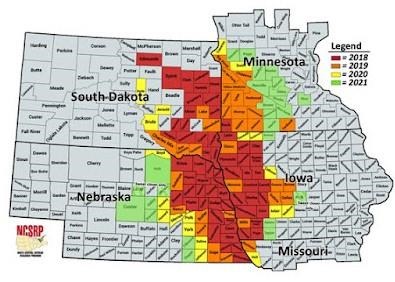By Bruce Potter
Soybean gall midge (SGM) has been found in 139 counties in five states with 25 new counties this year (Figure 1). Overall, 2021 crop injury from soybean gall midge in Minnesota has been less than previous years. However, as the second larval generation developed during late July and August 2021, infestations became easier to locate and the soybean gall midge has now been detected in 12 more Minnesota counties.

Figure 1. Distribution of the soybean gall midge as of
August 18, 2021. Source: https://soybeangallmidge.org/.
These new county infestations were not at high SGM population densities. For most of these MN detects, dead or wilted plants (Figure 2) did not provide clues. We needed to look beneath normal-appearing canopies for symptoms at the base of stems (Figure 3). In some cases, brittle stems made finding the larvae easier but even then, only a few infested plants were typically found in these fields. For example, a sharp-eyed farmer in Traverse County found soybean gall midge by inspecting a single plant with a broken stem in one of his fields this week.